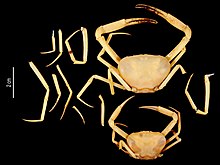| Typhlopseudothelphusa | |
|---|---|

| |
| Typhlopseudothelphusa juberthiei | |

| |
| Typhlopseudothelphusa mitchelli | |
| Scientific classification | |
| Domain: | Eukaryota |
| Kingdom: | Animalia |
| Phylum: | Arthropoda |
| Class: | Malacostraca |
| Order: | Decapoda |
| Suborder: | Pleocyemata |
| Infraorder: | Brachyura |
| Family: | Pseudothelphusidae |
| Genus: | Typhlopseudothelphusa Rioja, 1952 |
Typhlopseudothelphusa is a genus of subterranean-adapted (troglobionts) crabs in the family Pseudothelphusidae, containing the following species:
- Typhlopseudothelphusa acanthochela Hobbs, 1986
- Typhlopseudothelphusa hyba Rodríguez & Hobbs, 1989
- Typhlopseudothelphusa juberthiei Delamare Debouteville, 1976
- Typhlopseudothelphusa mitchelli Delamare Debouteville, 1976
- Typhlopseudothelphusa mocinoi Rioja, 1952
Description
All known Typhlopseudothelphusa species are adapted to the subterranean realm. They are depigmented (lack pigment), have no to highly reduced eyes/ eye stalks, and have elongated and slender appendages. As with all organisms adapted to the subterranean environment, these crabs occur in the deepest reaches of caves--known as the cave deep zone.
Etymology
The suffix Typhlo- from the genus name Typhlopseudothelphusa is derived from Greek typhlos for "blind", because complete blindness of the crabs from this genus due to the troglobitic lifestyle.
Distribution
Typhlopseudothelphusa crabs are known from fresh water in karstic caves from Central America.
References
- Howarth, F.G. (1980). "The Zoogeography of Specialized Cave Animals: A Bioclimatic Model". Evolution.
| Taxon identifiers | |
|---|---|
| Typhlopseudothelphusa | |
This Eubrachyura article is a stub. You can help Misplaced Pages by expanding it. |